Inpatient census 2018: part three
Results from the Hospital Based Complex Clinical Care (HBCCC) and Long Stay Census.
This document is part of a collection
1. Hospital Based Complex Clinical Care and Long Stay Patients
Number of HBCCC and Long Stay patients in Census
Overall, there were 1,773 Hospital Based Complex Clinical Care (HBCCC) or Long Stay (LS) patients at the 2018 Census. Of these, 937 (53%) were receiving HBCCC and 836 (47%) were LS (Long-stay). LS is defined here as patients in hospital for at least 6 months but not in receipt of HBCCC.
Of the 1,773 HBCCC or LS patients, 1,315 (74%) were occupying a Mental Health, Learning Disability or Addiction Inpatient Bed in an NHS Scotland Facility, 292 patients (16%) were in a General Acute / Community Hospital NHS Scotland facility, while 166 patients (9%) were treated outwith NHS Scotland (e.g. Private hospitals or NHS facilities elsewhere in the UK). See table 1 for a more detailed breakdown and comparisons to 2017 data.
| Inpatient Census | All Patients | HBCCC Patients | LS Patients | |||
|---|---|---|---|---|---|---|
| 2017 | 2018 | 2017 | 2018 | 2017 | 2018 | |
| Part 1: Mental Health Bed Census | 1,485 | 1,315 | 857 | 672 | 628 | 643 |
| Part 2: Out of Scotland NHS Placements | 85 | 166 | 39 | 42 | 46 | 124 |
| Part 3: HBCCC & LS (general acute) | 314 | 292 | 191 | 223 | 123 | 69 |
| All HBCCC patients in Inpatient Census | 1,884 | 1,773 | 1,087 | 937 | 797 | 836 |
Age and Gender
Figure 1 shows the age and gender breakdown of patients receiving HBCCC at the 2018 Census. Some key points include:
- Of the 937 HBCCC patients, 505 (54%) were male, while 412 (44%) were female. Data was missing/unknown for 20 patients (2%). Males represented 49% of the general Scottish population in 2017, suggesting males are over represented in HBCCC.
- Patients were mostly from the older age groups, 597 (64%) patients were aged 65 or over, a rise from 55% versus 2017. A further 212 (23%) were aged 40 - 64 at the time of the 2018 Census. There were 108 (12%) patients aged 18 - 39 and 19 (2%) patients under 18 receiving HBCCC at 2018 Census.
- Gender differences described are influenced by age. At the 2018 Census for patients aged under 40, 61% are male. This is a drop from 71% versus the 2017 Census. Of those aged 40 - 64 years in 2018, 60% are male. At the 65 or over group the gap closed with 50% male patients. This change will partly reflect the differing life expectancy of males (77.1 years, 2016) and females (81.1, 2016).
Figure 1: Number of patients receiving HBCCC, by age and gender, 2018
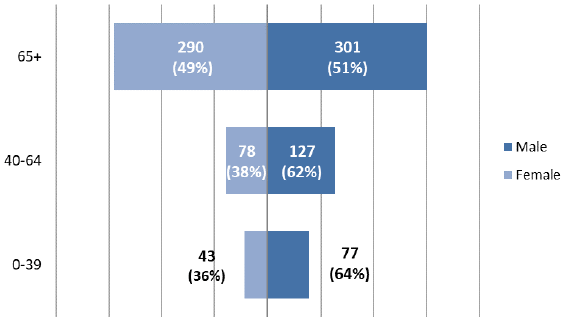
* Chart excludes those with unknown or refused gender
Figure 2 shows the age and gender breakdown of LS patients at the 2018 Census. Some key points include:
- Of the 836 patients, 543 (65%) were male, while 280 (33%) were female. Data was missing/unknown for 13 patients (2%). Males represented 49% of the general Scottish population in 2017, suggesting males are over represented.
- Patients were mostly from the older age groups, with 411 (49%) aged 40 - 64 years and a further 203 (24%) aged 65 or over. There were 209 (25%) LS patients aged 18 - 39 and 13 (2%) LS patients under 18 at 2018 Census.
- Gender differences described are influenced by age. For patients aged under 40, 68% are male, while a similar proportion of patients aged 40 - 64 years, 68%, are male. The proportion for the 65 or over group is 54% male. This change will partly reflect the differing life expectancy of males (77.1 years, 2016) and females (81.1, 2016).
Figure 2: Number of LS patients, by age and gender, 2018
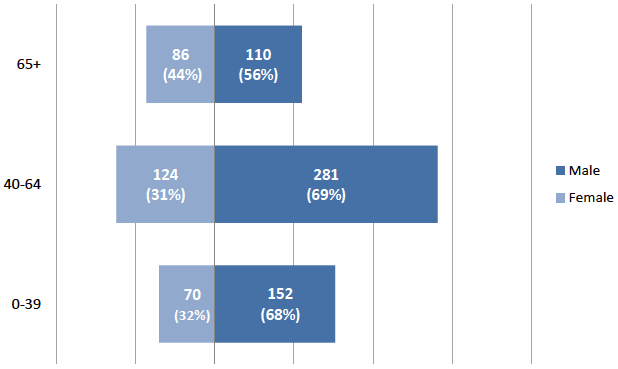
* Chart excludes those with unknown or refused gender
Ethnicity
The majority of HBCCC or LS patients at the 2018 Census, for whom ethnicity was known, described themselves as being of White Scottish ethnicity, 1,256 (71%). A further 242 (14%) patients were of another White ethnicity. Information was not known or refused for 232 patients. See figure 3 for further details.
Figure 3: Number of HBCCC or LS patients by ethnicity, 2018
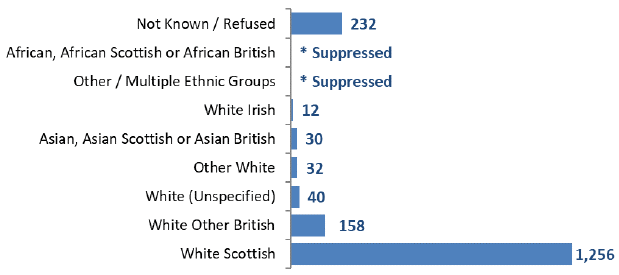
Consultant Specialty
As part of the Census, NHS Boards were asked to record the medical specialty of the consultants responsible for overseeing the treatment of each patient in the Census.
Of the 937 patients receiving HBCCC at the 2018 Census, 438 (47%) had a consultant who specialised in Psychiatry of Old Age, a rise versus the 2017 figure of 36%. In 2018 165 (18%) had a consultant specialising in Geriatric Medicine and 140 (15%) in General Psychiatry. See figure 4 for further details.
Figure 4: Number of patients receiving HBCCC by consultant specialty, 2018
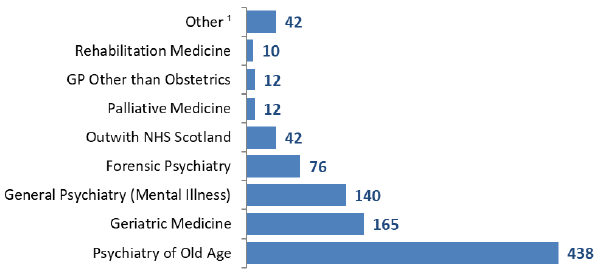
1 Other includes a range of specialties with smaller numbers that have been aggregated to protect patient confidentiality as well as patients with a missing or unknown specialty
Of the 836 LS patients at the Census, 278 (33%) had a consultant who specialised in General Psychiatry, 194 (23%) had a consultant specialising in Forensic Psychiatry and 125 (15%) in Psychiatry of Old Age. See figure 5 for further details.
Figure 5: Number of LS patients, by consultant specialty, 2018
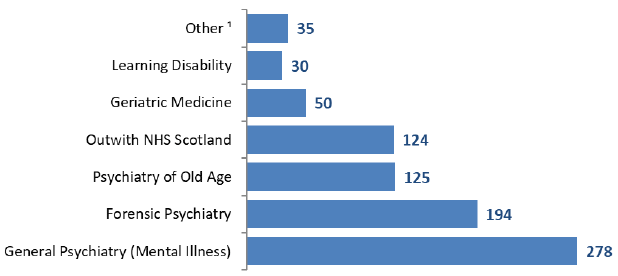
1 Other includes a range of specialties with smaller numbers that have been aggregated to protect patient confidentiality as well as patients with a missing or unknown specialty
NHS Board Breakdown
NHS Lothian were responsible for funding the treatment of 377 HBCCC patients (40%), followed by NHS Greater Glasgow & Clyde with 284 (30%). NHS Lothian's proportion rose from 31% at the last Census. NHS Shetland and NHS Western Isles had no patients in receipt of HBCCC. See figure 6 for further details.
Figure 6: Number of patients receiving HBCCC by Funding NHS Board, 2018
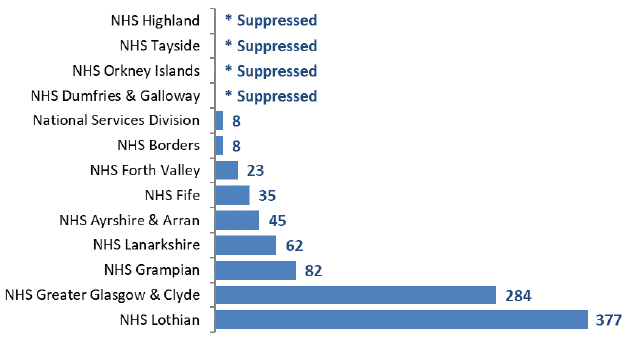
* Numbers have been suppressed to protect patient confidentiality
** National Services Division is funded by the territorial NHS Boards, and provides funding for a small number of patients in cases where they may require more specialised, long-term or cost-intensive treatment
NHS Lothian had the highest rate of HBCCC patients at 42.4 per 100,000 population. NHS Greater Glasgow & Clyde (24.3) and NHS Grampian (14.0) had the next highest rates. See figure 7 for further details.
Figure 7: Rate of HBCCC patients per 100,000 population, by Funding NHS Board, 2018
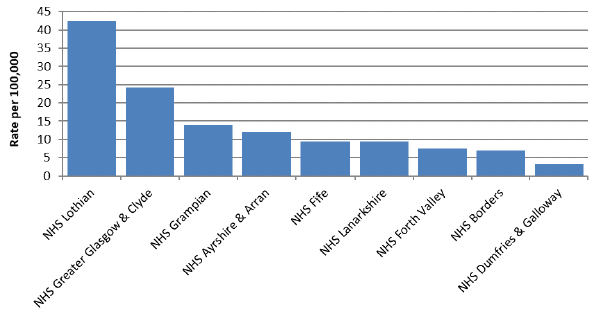
* Excludes Health Boards who have been suppressed to protect patient confidentiality
NHS Greater Glasgow & Clyde were responsible for funding the treatment of 182 LS patients (22%). NHS Lothian had the next highest number with 164 (20%). See figure 8 for further details.
Figure 8: Number of LS patients by Funding NHS Board, 2018
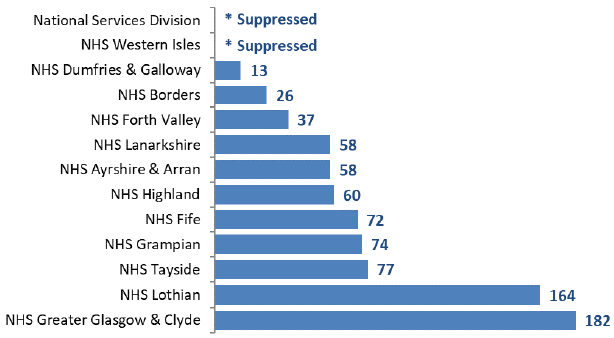
* Numbers have been suppressed to protect patient confidentiality
** National Services Division is funded by the territorial NHS Boards, and provides funding for a small number of patients in cases where they may require more specialised, long-term or cost-intensive treatment
NHS Borders had the highest rate of LS patients at 22.6 per 100,000 population. NHS Fife (19.4) had the next highest rate. See figure 9 for further details.
Figure 9: Rate of LS patients per 100,000 population, by Funding NHS Board, 2018
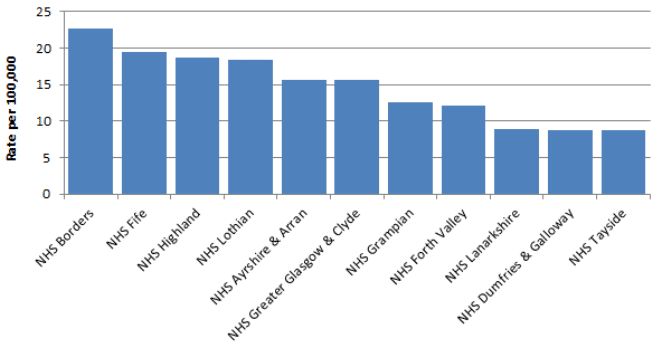
* Excludes Health Boards who have been suppressed to protect patient confidentiality
Local Authority Breakdown
Figure 10 provides analysis of patients in receipt of HBCCC by Local Authority of residence (based on the patient's home postcode). Where a Local Authority has between 1-4 patients in receipt of HBCCC the figure has been suppressed to protect patient confidentiality. Edinburgh City had more HBCCC patients than any other Local Authority at the 2018 Census with 270 patients (29%). Glasgow City had the next highest number with 157 (17%). Edinburgh City's proportion rose from 21% in 2017 to 29% in 2018.
Figure 10: Number of patients receiving HBCCC by LA of home post code, 2018
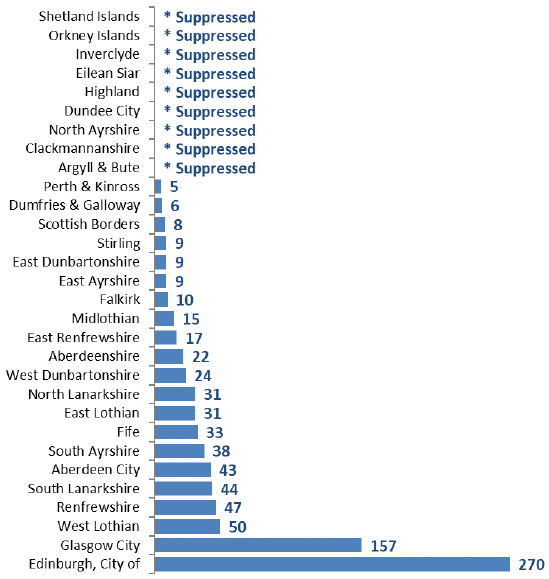
* Data unknown for 41 patients
Figure 11 provides analysis of LS patients by Local Authority of residence (based on the patient's home postcode). As previously mentioned, where a Local Authority has between 1-4 LS patients the figure has been suppressed to protect patient confidentiality. Glasgow City had more LS patients than any other Local Authority at the 2018 Census with 119 patients (14%). Edinburgh City had the next highest number with 116 (14%).
Figure 11: Number of LS patients by LA of home post code, 2018
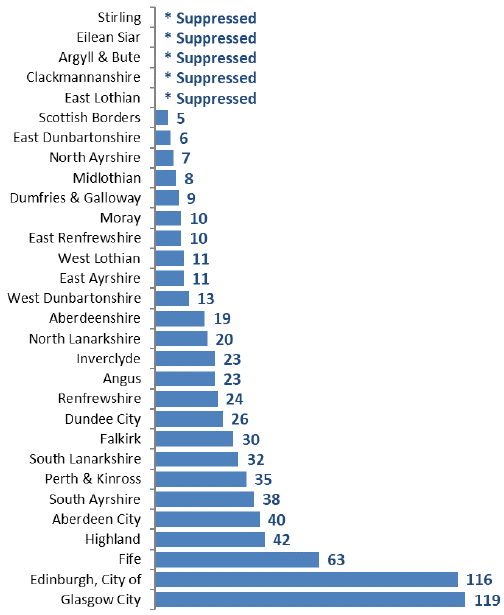
* Data unknown for 83 patients
Length of Stay in Hospital
NHS Boards were asked to record how long patients had been in hospital at the 2018 Census date. The average (median) time in hospital for HBCCC patients was 539 days (approximately 1 year and 6 months). For LS patients, the average (median) time in hospital was 649 days (approximately 1 year and 9 months). The spread of length of stay for patients can be seen in Table 2.
Table 2: Length of Stay, HBCCC and LS patients, 2018
| Length of Stay | HBCCC Patients | LS Patients |
|---|---|---|
| Less than 6 months | 269 | 0 |
| At least 6 months, less than 1 year | 119 | 238 |
| At least 1 year, less than 3 years | 265 | 308 |
| At least 3 year, less than 5 years | 119 | 104 |
| 5 years or more | 161 | 182 |
| Median | 539 | 649 |
* Admission date unknown for 5 patients
Health Conditions
NHS Boards were asked to return information on any health conditions a patient had been diagnosed with. Figure 12 shows the top six conditions for HBCCC and LS patients at the 2018 Census. The most prevalent was Mental Health with 724 (77%) HBCCC and 762 (91%) LS patients.
Figure 12: Health Conditions diagnoses, HBCCC and LS patients, 2018
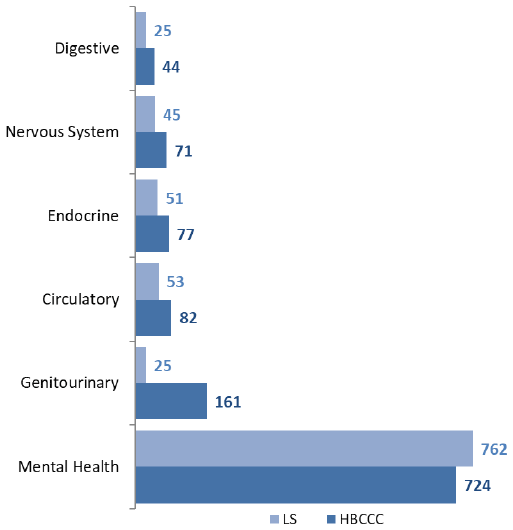
* Patients can have more than one condition
Contact
Email: Darren Meek
There is a problem
Thanks for your feedback